+ Open data
Open data
- Basic information
Basic information
| Entry | Database: PDB / ID: 2br9 | ||||||
|---|---|---|---|---|---|---|---|
| Title | 14-3-3 Protein Epsilon (Human) Complexed to Peptide | ||||||
 Components Components |
| ||||||
 Keywords Keywords | CELL REGULATOR PROTEIN /  14-3-3 / 14-3-3 /  PHOSPHOSERINE / PHOSPHOSERINE /  STRUCTURAL GENOMICS CONSORTIUM / SGC / STRUCTURAL GENOMICS CONSORTIUM / SGC /  YWHAE YWHAE | ||||||
| Function / homology |  Function and homology information Function and homology informationnegative regulation of peptidyl-serine dephosphorylation / regulation of heart rate by hormone / regulation of potassium ion transmembrane transporter activity / negative regulation of calcium ion transmembrane transporter activity / membrane repolarization during cardiac muscle cell action potential / regulation of membrane repolarization / NADE modulates death signalling / RAB GEFs exchange GTP for GDP on RABs / Signaling by Hippo / negative regulation of calcium ion export across plasma membrane ...negative regulation of peptidyl-serine dephosphorylation / regulation of heart rate by hormone / regulation of potassium ion transmembrane transporter activity / negative regulation of calcium ion transmembrane transporter activity / membrane repolarization during cardiac muscle cell action potential / regulation of membrane repolarization / NADE modulates death signalling / RAB GEFs exchange GTP for GDP on RABs / Signaling by Hippo / negative regulation of calcium ion export across plasma membrane / Deregulated CDK5 triggers multiple neurodegenerative pathways in Alzheimer's disease models / cytoplasmic pattern recognition receptor signaling pathway / regulation of heart rate by cardiac conduction / calcium channel regulator activity / protein localization to nucleus / phosphoserine residue binding / HSF1 activation /  protein targeting / Regulation of HSF1-mediated heat shock response / Activation of BAD and translocation to mitochondria / potassium channel regulator activity / SARS-CoV-2 targets host intracellular signalling and regulatory pathways / signaling adaptor activity / Chk1/Chk2(Cds1) mediated inactivation of Cyclin B:Cdk1 complex / SARS-CoV-1 targets host intracellular signalling and regulatory pathways / RHO GTPases activate PKNs / Loss of Nlp from mitotic centrosomes / Loss of proteins required for interphase microtubule organization from the centrosome / Recruitment of mitotic centrosome proteins and complexes / Recruitment of NuMA to mitotic centrosomes / regulation of mitotic cell cycle / regulation of cytosolic calcium ion concentration / Anchoring of the basal body to the plasma membrane / substantia nigra development / AURKA Activation by TPX2 / protein sequestering activity / positive regulation of protein export from nucleus / Translocation of SLC2A4 (GLUT4) to the plasma membrane / protein targeting / Regulation of HSF1-mediated heat shock response / Activation of BAD and translocation to mitochondria / potassium channel regulator activity / SARS-CoV-2 targets host intracellular signalling and regulatory pathways / signaling adaptor activity / Chk1/Chk2(Cds1) mediated inactivation of Cyclin B:Cdk1 complex / SARS-CoV-1 targets host intracellular signalling and regulatory pathways / RHO GTPases activate PKNs / Loss of Nlp from mitotic centrosomes / Loss of proteins required for interphase microtubule organization from the centrosome / Recruitment of mitotic centrosome proteins and complexes / Recruitment of NuMA to mitotic centrosomes / regulation of mitotic cell cycle / regulation of cytosolic calcium ion concentration / Anchoring of the basal body to the plasma membrane / substantia nigra development / AURKA Activation by TPX2 / protein sequestering activity / positive regulation of protein export from nucleus / Translocation of SLC2A4 (GLUT4) to the plasma membrane /  mitochondrial membrane / hippocampus development / TP53 Regulates Metabolic Genes / mitochondrial membrane / hippocampus development / TP53 Regulates Metabolic Genes /  phosphoprotein binding / phosphoprotein binding /  neuron migration / cerebral cortex development / neuron migration / cerebral cortex development /  histone deacetylase binding / histone deacetylase binding /  Regulation of PLK1 Activity at G2/M Transition / Regulation of PLK1 Activity at G2/M Transition /  MAPK cascade / MAPK cascade /  melanosome / MHC class II protein complex binding / cellular response to heat / melanosome / MHC class II protein complex binding / cellular response to heat /  scaffold protein binding / scaffold protein binding /  protein phosphatase binding / transmembrane transporter binding / intracellular signal transduction / protein phosphatase binding / transmembrane transporter binding / intracellular signal transduction /  cadherin binding / protein heterodimerization activity / protein domain specific binding / cadherin binding / protein heterodimerization activity / protein domain specific binding /  focal adhesion / focal adhesion /  ubiquitin protein ligase binding / ubiquitin protein ligase binding /  enzyme binding / enzyme binding /  signal transduction / signal transduction /  RNA binding / extracellular exosome / RNA binding / extracellular exosome /  membrane / identical protein binding / membrane / identical protein binding /  nucleus / nucleus /  cytosol / cytosol /  cytoplasm cytoplasmSimilarity search - Function | ||||||
| Biological species |   HOMO SAPIENS (human) HOMO SAPIENS (human) | ||||||
| Method |  X-RAY DIFFRACTION / X-RAY DIFFRACTION /  SYNCHROTRON / SYNCHROTRON /  MOLECULAR REPLACEMENT / Resolution: 1.75 Å MOLECULAR REPLACEMENT / Resolution: 1.75 Å | ||||||
 Authors Authors | Yang, X. / Elkins, J.M. / Soundararajan, M. / Fedorov, O. / Sundstrom, M. / Edwards, A. / Arrowsmith, C. / Doyle, D.A. | ||||||
 Citation Citation |  Journal: Proc.Natl.Acad.Sci.USA / Year: 2006 Journal: Proc.Natl.Acad.Sci.USA / Year: 2006Title: Structural Basis for Protein-Protein Interactions in the 14-3-3 Protein Family. Authors: Yang, X. / Lee, W.H. / Sobott, F. / Papagrigoriou, E. / Robinson, C.V. / Grossmann, J.G. / Sundstrom, M. / Doyle, D.A. / Elkins, J.M. | ||||||
| History |
|
- Structure visualization
Structure visualization
| Structure viewer | Molecule:  Molmil Molmil Jmol/JSmol Jmol/JSmol |
|---|
- Downloads & links
Downloads & links
- Download
Download
| PDBx/mmCIF format |  2br9.cif.gz 2br9.cif.gz | 63.4 KB | Display |  PDBx/mmCIF format PDBx/mmCIF format |
|---|---|---|---|---|
| PDB format |  pdb2br9.ent.gz pdb2br9.ent.gz | 45.8 KB | Display |  PDB format PDB format |
| PDBx/mmJSON format |  2br9.json.gz 2br9.json.gz | Tree view |  PDBx/mmJSON format PDBx/mmJSON format | |
| Others |  Other downloads Other downloads |
-Validation report
| Arichive directory |  https://data.pdbj.org/pub/pdb/validation_reports/br/2br9 https://data.pdbj.org/pub/pdb/validation_reports/br/2br9 ftp://data.pdbj.org/pub/pdb/validation_reports/br/2br9 ftp://data.pdbj.org/pub/pdb/validation_reports/br/2br9 | HTTPS FTP |
|---|
-Related structure data
| Related structure data | 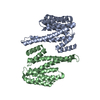 2bq0C  2btpC 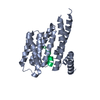 2c23C  2c63C 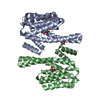 2c74C  1o9dS S: Starting model for refinement C: citing same article ( |
|---|---|
| Similar structure data |
- Links
Links
- Assembly
Assembly
| Deposited unit | 
| ||||||||
|---|---|---|---|---|---|---|---|---|---|
| 1 | 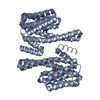
| ||||||||
| Unit cell |
| ||||||||
| Details | THE PROTEIN EXISTS IN PHYSIOGICALLY STATE AS A DIMER, HOWEVER, SINCE IN THIS STRUCTURE THIS IS IN COMPLEX WITH A SHORT PEPTIDE (CHAIN P), THE OVERALL COMPLEX IS DESIGNATED AS A TETRAMER. |
- Components
Components
| #1: Protein | Mass: 26791.498 Da / Num. of mol.: 1 Source method: isolated from a genetically manipulated source Source: (gene. exp.)   HOMO SAPIENS (human) HOMO SAPIENS (human)Description: THE MAMMALIAN GENE COLLECTION, I.M.A.G.E. CONSORTIUM CLONE ID 3139004 Plasmid: PLIC-SGC / Production host:   ESCHERICHIA COLI (E. coli) / Strain (production host): BL21(DE3) / References: UniProt: P62258 ESCHERICHIA COLI (E. coli) / Strain (production host): BL21(DE3) / References: UniProt: P62258 |
|---|---|
| #2: Protein/peptide | Mass: 952.975 Da / Num. of mol.: 1 / Source method: obtained synthetically / Details: PHOSPHOSERINE AT RESIDUE P 5 / Source: (synth.)   HOMO SAPIENS (human) HOMO SAPIENS (human) |
| #3: Water | ChemComp-HOH /  Water Water |
| Sequence details | THE UNIPROT CROSS-REFERENCE GIVEN IN THE DBREF RECORDS BELOW CORRESPONDS TO GENBANK ENTRY BC000179. ...THE UNIPROT CROSS-REFERENCE GIVEN IN THE DBREF RECORDS BELOW CORRESPOND |
-Experimental details
-Experiment
| Experiment | Method:  X-RAY DIFFRACTION / Number of used crystals: 1 X-RAY DIFFRACTION / Number of used crystals: 1 |
|---|
- Sample preparation
Sample preparation
| Crystal | Density Matthews: 2.4 Å3/Da / Density % sol: 48.5 % |
|---|---|
Crystal grow | pH: 8 Details: 40% MPD, 5% PEG10000, 0.1M CACODYLATE PH6.5. PROTEIN IN 150MM NACL, 50MM TRIS PH8, pH 8.00 |
-Data collection
| Diffraction | Mean temperature: 100 K |
|---|---|
| Diffraction source | Source:  SYNCHROTRON / Site: SYNCHROTRON / Site:  SLS SLS  / Beamline: X10SA / Wavelength: 0.968 / Beamline: X10SA / Wavelength: 0.968 |
| Detector | Type: MARRESEARCH / Detector: CCD / Date: Apr 23, 2005 |
| Radiation | Protocol: SINGLE WAVELENGTH / Monochromatic (M) / Laue (L): M / Scattering type: x-ray |
| Radiation wavelength | Wavelength : 0.968 Å / Relative weight: 1 : 0.968 Å / Relative weight: 1 |
| Reflection | Resolution: 1.75→36.42 Å / Num. obs: 138812 / % possible obs: 99.2 % / Redundancy: 5.3 % / Rmerge(I) obs: 0.09 / Net I/σ(I): 16.1 |
| Reflection shell | Resolution: 1.75→1.84 Å / Redundancy: 3.7 % / Rmerge(I) obs: 0.64 / Mean I/σ(I) obs: 1.9 / % possible all: 97.4 |
- Processing
Processing
| Software |
| ||||||||||||||||||||||||||||||||||||||||||||||||||||||||||||||||||||||||||||||||||||||||||||||||||||||||||||||||||||||||||||||||||||||||||||||||||||||||||||||||||||||||||||||||||||||
|---|---|---|---|---|---|---|---|---|---|---|---|---|---|---|---|---|---|---|---|---|---|---|---|---|---|---|---|---|---|---|---|---|---|---|---|---|---|---|---|---|---|---|---|---|---|---|---|---|---|---|---|---|---|---|---|---|---|---|---|---|---|---|---|---|---|---|---|---|---|---|---|---|---|---|---|---|---|---|---|---|---|---|---|---|---|---|---|---|---|---|---|---|---|---|---|---|---|---|---|---|---|---|---|---|---|---|---|---|---|---|---|---|---|---|---|---|---|---|---|---|---|---|---|---|---|---|---|---|---|---|---|---|---|---|---|---|---|---|---|---|---|---|---|---|---|---|---|---|---|---|---|---|---|---|---|---|---|---|---|---|---|---|---|---|---|---|---|---|---|---|---|---|---|---|---|---|---|---|---|---|---|---|---|
| Refinement | Method to determine structure : :  MOLECULAR REPLACEMENT MOLECULAR REPLACEMENTStarting model: PDB ENTRY 1O9D Resolution: 1.75→56.34 Å / Cor.coef. Fo:Fc: 0.955 / Cor.coef. Fo:Fc free: 0.928 / SU B: 4.503 / SU ML: 0.074 / TLS residual ADP flag: LIKELY RESIDUAL / Cross valid method: THROUGHOUT / ESU R: 0.113 / ESU R Free: 0.119 / Stereochemistry target values: MAXIMUM LIKELIHOOD / Details: HYDROGENS HAVE BEEN ADDED IN THE RIDING POSITIONS.
| ||||||||||||||||||||||||||||||||||||||||||||||||||||||||||||||||||||||||||||||||||||||||||||||||||||||||||||||||||||||||||||||||||||||||||||||||||||||||||||||||||||||||||||||||||||||
| Solvent computation | Ion probe radii: 0.8 Å / Shrinkage radii: 0.8 Å / VDW probe radii: 1.2 Å / Solvent model: MASK | ||||||||||||||||||||||||||||||||||||||||||||||||||||||||||||||||||||||||||||||||||||||||||||||||||||||||||||||||||||||||||||||||||||||||||||||||||||||||||||||||||||||||||||||||||||||
| Displacement parameters | Biso mean: 28.45 Å2
| ||||||||||||||||||||||||||||||||||||||||||||||||||||||||||||||||||||||||||||||||||||||||||||||||||||||||||||||||||||||||||||||||||||||||||||||||||||||||||||||||||||||||||||||||||||||
| Refinement step | Cycle: LAST / Resolution: 1.75→56.34 Å
| ||||||||||||||||||||||||||||||||||||||||||||||||||||||||||||||||||||||||||||||||||||||||||||||||||||||||||||||||||||||||||||||||||||||||||||||||||||||||||||||||||||||||||||||||||||||
| Refine LS restraints |
|
 Movie
Movie Controller
Controller




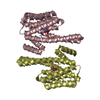
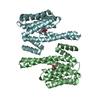

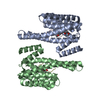

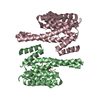
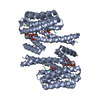


 PDBj
PDBj












